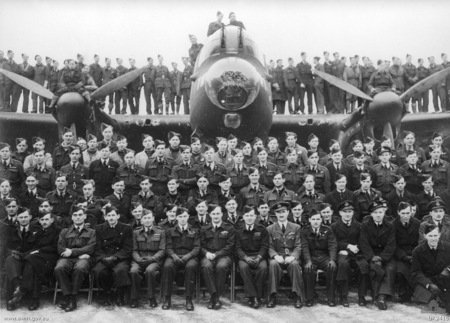Australia forgets

It's Anzac Day once again. On Anzac Day, Australia remembers some things but forgets others. We remember the sacrifices of the original Anzacs at Gallipoli, but forget that it wasn't only Australians who suffered. We remember the many thousands of young Australians who have fought in foreign wars since then, but forget to ask why they were there. We remember that war can bring out the best in people, but forget that it can also bring out the worst.
One thing we tend to forget is Australia's part in the bombing of Europe in the Second World War. There are a few memorials and exhibits, but when we think of Anzacs we usually think of slouch hats, not flying helmets.

Eight Royal Australian Air Force squadrons served with RAF Bomber Command at various times: 455, 458, 460 (members of which can be seen above arranged in front of -- and on top of -- one of their Lancasters), 462, 463, 464, 466 and 467. Many other Australians flew with RAF heavy bomber squadrons, just as many non-Australians did with the RAAF squadrons. (Often outnumbering the Australians, in fact: when 462 was formed, only one of its aircrew was Australian.) In total, around 10,000 Australians served in Bomber Command during the war, at stations like this one at Waddington, home to 463 and 467 Squadrons for the war's last eighteen months.
The butcher's bill was enormous: of those 10,000, nearly 3500 Australian airmen were killed, out of 10,500 RAAF deaths for the whole war and 39,300 for all three services. That is, one in eleven of Australian service personnel who died in the war did so while serving in Bomber Command. One in three of those Australians who fought their war in the night skies above Europe never came home again. Two hundred men from 463 Squadron were killed in the eight months before D-Day, 130 per cent of its establishment strength.
Above is a RAAF Lancaster of 463 Squadron over Normandy in July 1944. One of its engines is on fire and the crew are about to bail out; two were killed and three taken prisoner.
But to focus on just the Australian casualties would also be a form of forgetting. They didn't join Bomber Command to die but to fight. RAAF aircrew and squadrons played an important role in many of Bomber Command's most famous operations: busting the Ruhr dams, the Amiens prison raid, sinking the Tirpitz. But they also took part in all of the RAF's big assaults on German cities: Cologne, Hamburg, Berlin, and so many others.
Above is one of 460 Squadron's Lancasters bombing Freiburg on the night of 27 November 1944, part of a raid which killed about 3000 civilians.
This is Dresden on 14 February 1945, the day after the Allies began their attack on the city. Three RAAF squadrons -- 460, 463 and 467 -- helped to create the firestorm in which 25,000 people, mostly civilians, were killed. At a minimum, the Combined Bomber Offensive killed at least 300,000 civilians in Germany, and many thousands more in occupied Europe. Some proportion of those were killed by Australians -- under British command, true, but with the acquiescence and approval of the Australian government and the great majority of its people. Unlike in Britain, the moral questions surrounding the area bombing of cities in the Second World War have never been controversial in Australia, or even seriously questioned, not atthetime, not afterwards. They are glossed over. And when our bomber boys are remembered, just what they bombed is not.
I'm not against Anzac Day at all. It's good to have a day to remember those who fought and those who died for us. But Anzac Day allows us to talk about some things to do with Australia's wars, and not about others. If we remember the great and heroic deeds done in our name, we should also remember those things which are perhaps less comfortable to dwell on. And ask why they happened, and whether they could happen again.
Image sources: Australian War Memorial P03127.002, SUK13470, SUK13775, UK2288, UK2416.
Further reading: Alan Stephens, The Royal Australian Air Force (Melbourne: Oxford University Press, 2001), chapter 5.